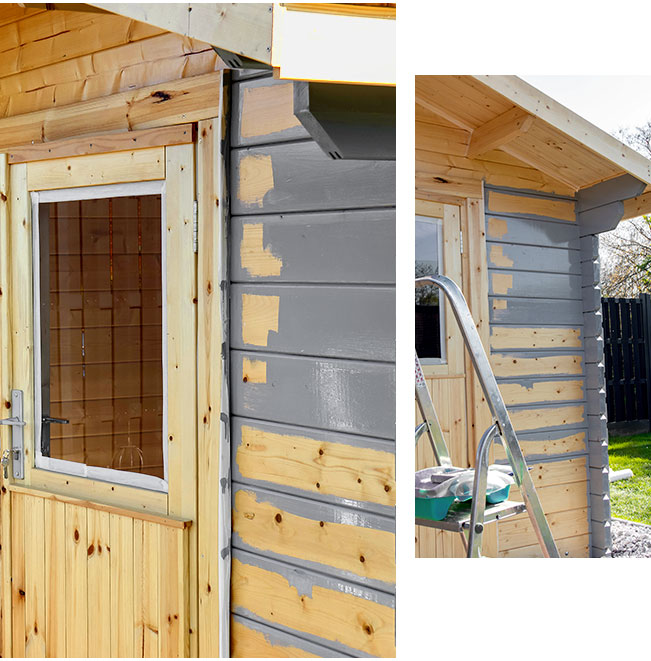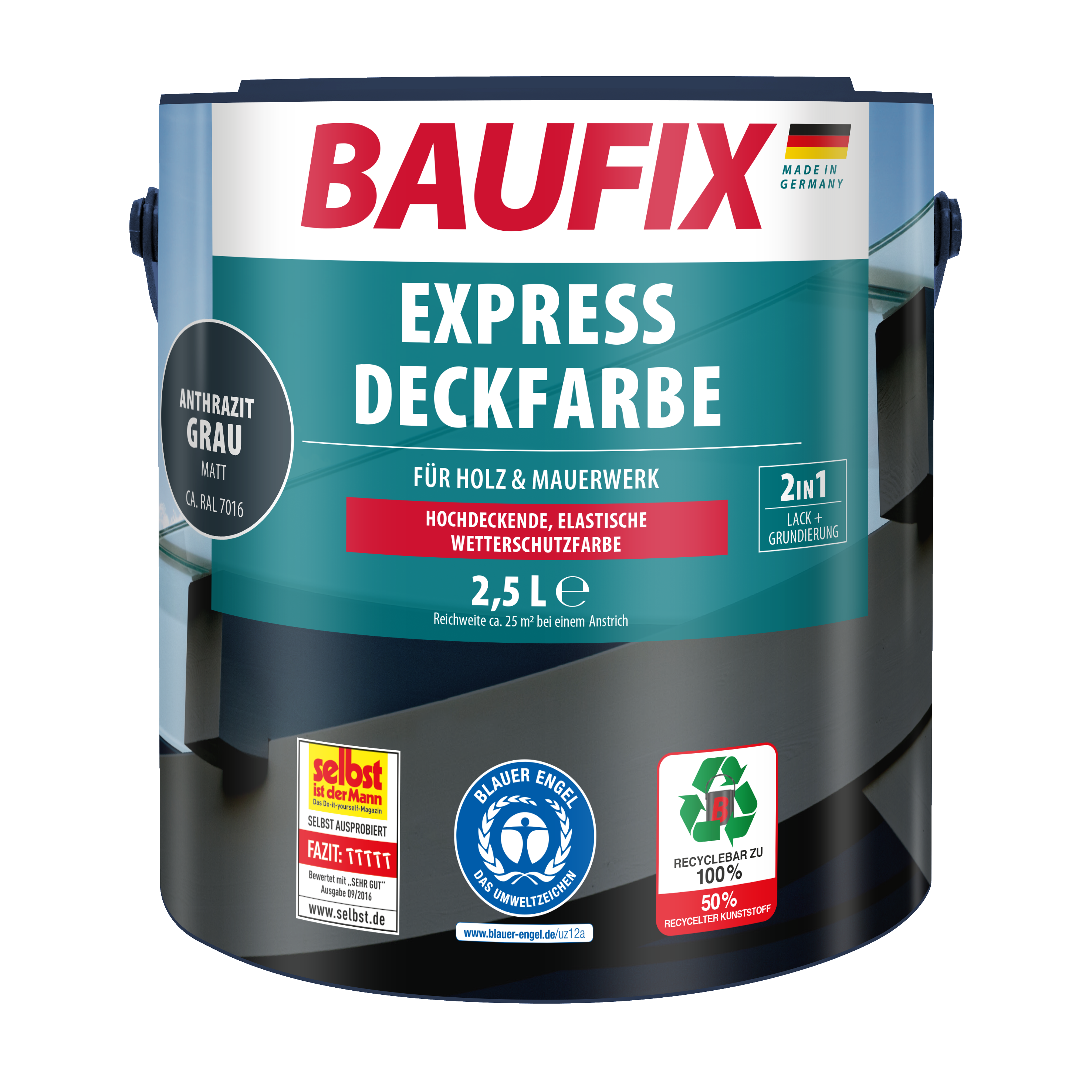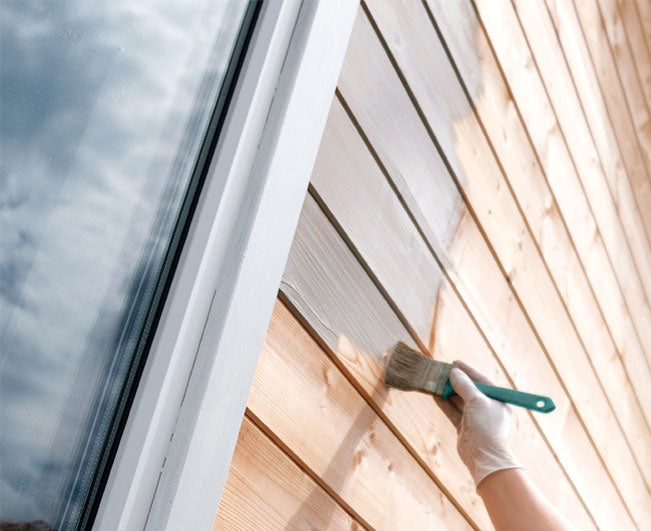Gartenhaus streichen - Tipps & Tricks
subheading
Painting a garden house: Fresh paint for the gazebo
The garden house is a popular fixture in your garden. It often looks very pretty and serves as a place to store patio furniture, cushions, etc. or is often used as a lounge area when the weather is bad, but it needs regular care. Even though garden houses are usually made from local softwoods such as spruce, which are considered to be quite robust, UV radiation, moisture and frost can take their toll on the wood over time. But don't worry! What sounds like a lot of work is actually done quickly. Painting a garden house made easy - we'll explain what you need to look out for.
Why you should paint your garden shed
Would you like to add a colorful accent to your garden with your garden house? Then painting your wooden house in your preferred color is just the thing for you! In addition to the attractive appearance, our opaque paints primarily offer protection against wind and weather and thus keep your house in good condition in the long term. Do you prefer the natural look of the wooden house? Then we recommend that you varnish your garden house.

subheading
Painting a garden shed: We'll explain how it's done!
To paint your garden house, you will need the desired color and primer as well as a simple flat brush. To prevent unwanted stains and streaks caused by paint on the floor, windows, etc., we recommend generously masking off neighboring components or covering them with foil or painter's fleece. You should have a spatula and possibly a sander to hand for any necessary touch-ups. The wood should be even and free of dirt for the paint treatment.
Also, choose a rain-free day with outside temperatures of at least 10 degrees Celsius to paint your garden shed. The most suitable months are spring and summer.
subheading
Step 1: Planning for painting the garden house
Even if the actual painting of the wooden house is done quickly, a few more steps may be required before the garden house can finally be painted. So it's best to take a look at the condition of the current varnish or paint to plan enough time for possible preparation work such as sanding, removing resin, etc.
Step 2: Cleaning and preparation
If the garden house has been in your garden for a while, a lot of dirt has probably settled on the wooden house. You can easily remove loose dirt with a broom. For more stubborn dirt such as moss etc. you can use a brush to scrub or even use a high-pressure cleaner. Linseed oil soap can also be used to clean wood that has become dirty due to the weather. In principle, it is not absolutely necessary to sand the wood before painting the garden house. Dirt and dust must still be thoroughly removed. Cracks and other damage will still be visible in this case. If you notice that the wood is uneven or the old glaze/paint is peeling off, you should definitely remove the old layers with a sander or sandpaper (80 grain) before you can paint the garden house. Remember to sweep away the dust that is created before painting.
Step 3: Mask off areas not to be painted
Thoroughly cover frames, windows, door glazing, roof panels on flat roofs and small parts that are not to be painted with masking tape. If possible, you can dismantle doors and windows to make your work easier.
In this step, don't forget the area around the garden house. Place a covering sheet on the surrounding areas such as lawn, tiles or stone paving to protect them from paint splashes and discoloration.
subheading
Step 4: Priming and impregnating
After cleaning and before you can paint your garden shed, the wood must first be treated. Suitable products for this are wood primer, wood preservative primer, or an impregnating glaze. The impregnation protects untreated softwood, such as spruce or pine, from fungal infestation and swelling while also providing a good adhesion base for the subsequent paint. Apply the impregnation layer undiluted with a brush to the raw or previously sanded wood. If you notice dents or holes in the softwood, you can fill these with a spatula. Want to paint your shed in bright colors? For light pastel shades or white, apply two additional coats of impregnation. Without this sufficient isolating base, there is a risk of resin bleeding and yellowing of light lacquer coats. After about 24 hours of drying time, you can now paint your primed shed with color.
Step 5: Painting the garden house
To paint the garden shed, it is best to use our top coat undiluted and apply it twice. When using your painting technique, make sure that you always paint in the direction of the wood grain with the brush. Alternatively, you can use a foam roller to paint the garden shed for larger areas. After the first coat has dried (approximately 4 hours, depending on the temperature and weather), you can apply the final coat. To achieve the best result, the painted wood must be protected from rain for approx. 4 hours.
Is your garden house brand new? Then you should paint the garden house before it is built. This way you can treat the wooden boards right down to the smallest corner and thus protect them comprehensively from moisture and the like.
Tip:
Like the garden house, you can also paint wood and roof cladding, a carport or the pergola. However, our opaque paints are not suitable for painting floors or wooden garden furniture. Use our patio and garden furniture glaze for this.

subheading
Our garden house covering paint: BAUFIX Express covering paint
- faster drying, allowing two coats per day
- significantly higher longevity
- increased weather resistance
- for outside and inside
- for wood, plaster, masonry, etc.
Wie oft sollte ich das Gartenhaus streichen?
Nach dem Gartenhaus streichen hast du vermutlich erstmal genug davon. Glücklicherweise ist ein Anstrich auch gar nicht allzu häufig von Nöten. Je nach Sonne, Regen, Wind und anderen Einflüssen hält sich die Farbe mit ihrer Schutzfunktion um die 2 Jahre. Solltest du feststellen, dass die Farbe abbröckelt, solltest du nicht einfach nur überstreichen, sondern alles komplett abschleifen und erneut mit der Grundierung beginnen.
Gartenhaus streichen: Wann ist der beste Zeitpunkt dafür?
Da sowohl Grundierung als auch Farbe ihre Zeit zum Trocknen benötigen, sollte die Temperatur nicht unter 10 Grad Celsius liegen und die Luftfeuchtigkeit nicht zu hoch sein. Idealerweise ist es mit bis maximal 25 Grad Celsius etwas wärmer, bewölkt, um direkte Sonneneinstrahlung zu verhindern, aber trocken. Die beste Zeit zum Gartenhaus streichen sind daher die Frühlings- oder Sommermonate. Bei niedrigerer Temperatur und hoher Luftfeuchtigkeit verlängert sich Trocknungszeit.
Gartenhaus streichen: Welche Farbe?
Unsere Deckfarben schützen dein Holz vor Feuchtigkeit und blättern nicht. Die Wetterschutzfarben sorgen dafür, dass Witterung und Sonneneinstrahlung dem Holz nichts anhaben können. Unsere BAUFIX Express-Deckfarbe gibt es in verschiedenen attraktiven Farbtönen und verleiht deinem Gartenhaus langanhaltenden Schutz bei besonders einfacher Verarbeitung.
Die Wahl der Farbe für dein Gartenhaus hängt von mehreren Faktoren ab. Berücksichtige den Architekturstil deines Wohnhauses und Gartenhauses, um eine Farbe zu wählen, die diesen Stil ergänzt. Natürliche Holzfarben passen gut in grüne, bewaldete Umgebungen, während kräftige Primärfarben auf großen Grünflächen auffallen. In blühenden Gärten harmonieren Farbtöne, die sich in die Pflanzenwelt einfügen.

subheading
Should I varnish or paint my garden house?
The decision whether to varnish or paint your garden shed depends on your needs and aesthetic preferences. Wood varnishes preserve the natural look of the wood by leaving the structure and grain visible. Applying wood oil is popular for larch and teak. Varnishes penetrate the wood, allow it to breathe and regulate moisture, which reduces the risk of cracks and warping. They offer protection for around two to three years and, depending on the color, provide good UV protection.
Protective varnishes provide an opaque, even layer of paint that completely covers the wood and sets colorful accents. Wood varnishes form a water-repellent and elastic protective layer that lasts for about four to five years. The color-treated wood is effectively protected from the effects of the weather during this time. This method is particularly suitable if you prefer a robust, long-lasting coating.


